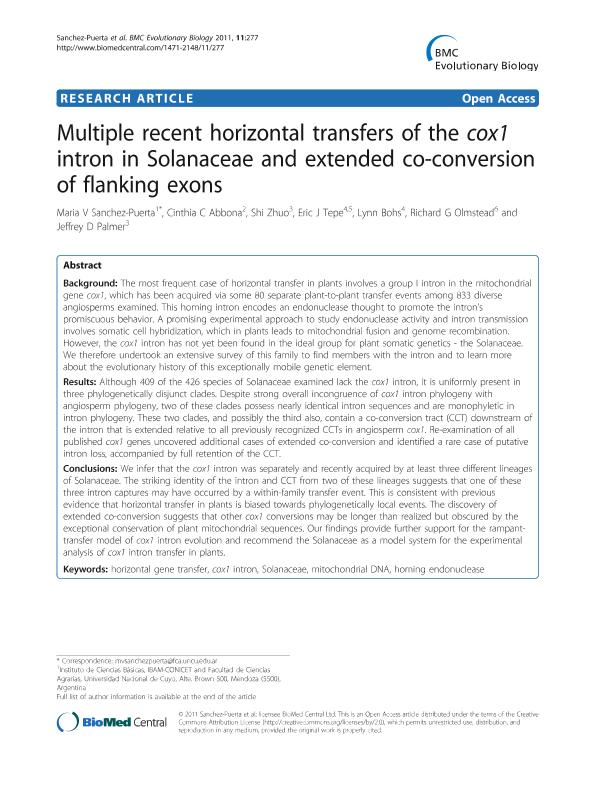Artículo
Multiple recent horizontal transfers of the cox1 intron in Solanaceae and extended co-conversion of flanking exons
Sánchez Puerta, María Virginia ; Abbona, Cinthia Carolina
; Abbona, Cinthia Carolina ; Zhuo, Shi; Tepe, Eric J.; Bohs, Lynn; Olmstead, Richard G.; Palmer, Jeffrey D.
; Zhuo, Shi; Tepe, Eric J.; Bohs, Lynn; Olmstead, Richard G.; Palmer, Jeffrey D.
 ; Abbona, Cinthia Carolina
; Abbona, Cinthia Carolina ; Zhuo, Shi; Tepe, Eric J.; Bohs, Lynn; Olmstead, Richard G.; Palmer, Jeffrey D.
; Zhuo, Shi; Tepe, Eric J.; Bohs, Lynn; Olmstead, Richard G.; Palmer, Jeffrey D.
Fecha de publicación:
09/2011
Editorial:
BioMed Central
Revista:
BMC Evolutionary Biology
ISSN:
1471-2148
Idioma:
Inglés
Tipo de recurso:
Artículo publicado
Clasificación temática:
Resumen
Background: The most frequent case of horizontal transfer in plants involves a group I intron in the mitochondrial gene cox1, which has been acquired via some 80 separate plant-to-plant transfer events among 833 diverse angiosperms examined. This homing intron encodes an endonuclease thought to promote the intron´s promiscuous behavior. A promising experimental approach to study endonuclease activity and intron transmission involves somatic cell hybridization, which in plants leads to mitochondrial fusion and genome recombination. However, the cox1 intron has not yet been found in the ideal group for plant somatic genetics - the Solanaceae. We therefore undertook an extensive survey of this family to find members with the intron and to learn more about the evolutionary history of this exceptionally mobile genetic element. Results: Although 409 of the 426 species of Solanaceae examined lack the cox1 intron, it is uniformly present in three phylogenetically disjunct clades. Despite strong overall incongruence of cox1 intron phylogeny with angiosperm phylogeny, two of these clades possess nearly identical intron sequences and are monophyletic in intron phylogeny. These two clades, and possibly the third also, contain a co-conversion tract (CCT) downstream of the intron that is extended relative to all previously recognized CCTs in angiosperm cox1. Re-examination of all published cox1 genes uncovered additional cases of extended co-conversion and identified a rare case of putative intron loss, accompanied by full retention of the CCT. Conclusions: We infer that the cox1 intron was separately and recently acquired by at least three different lineages of Solanaceae. The striking identity of the intron and CCT from two of these lineages suggests that one of these three intron captures may have occurred by a within-family transfer event. This is consistent with previous evidence that horizontal transfer in plants is biased towards phylogenetically local events. The discovery of extended co-conversion suggests that other cox1 conversions may be longer than realized but obscured by the exceptional conservation of plant mitochondrial sequences. Our findings provide further support for the rampant-transfer model of cox1 intron evolution and recommend the Solanaceae as a model system for the experimental analysis of cox1 intron transfer in plants.
Palabras clave:
MITOCHONDRIAL DNA
,
COX1 INTRON
,
MITOCHONDRIAL DNA
,
HOMING ENDONUCLEASE
Archivos asociados
Licencia
Identificadores
Colecciones
Articulos(IBAM)
Articulos de INST.DE BIOLOGIA AGRICOLA DE MENDOZA
Articulos de INST.DE BIOLOGIA AGRICOLA DE MENDOZA
Citación
Sánchez Puerta, María Virginia; Abbona, Cinthia Carolina; Zhuo, Shi; Tepe, Eric J.; Bohs, Lynn; et al.; Multiple recent horizontal transfers of the cox1 intron in Solanaceae and extended co-conversion of flanking exons; BioMed Central; BMC Evolutionary Biology; 11; 277; 9-2011; 277-292
Compartir
Altmétricas



